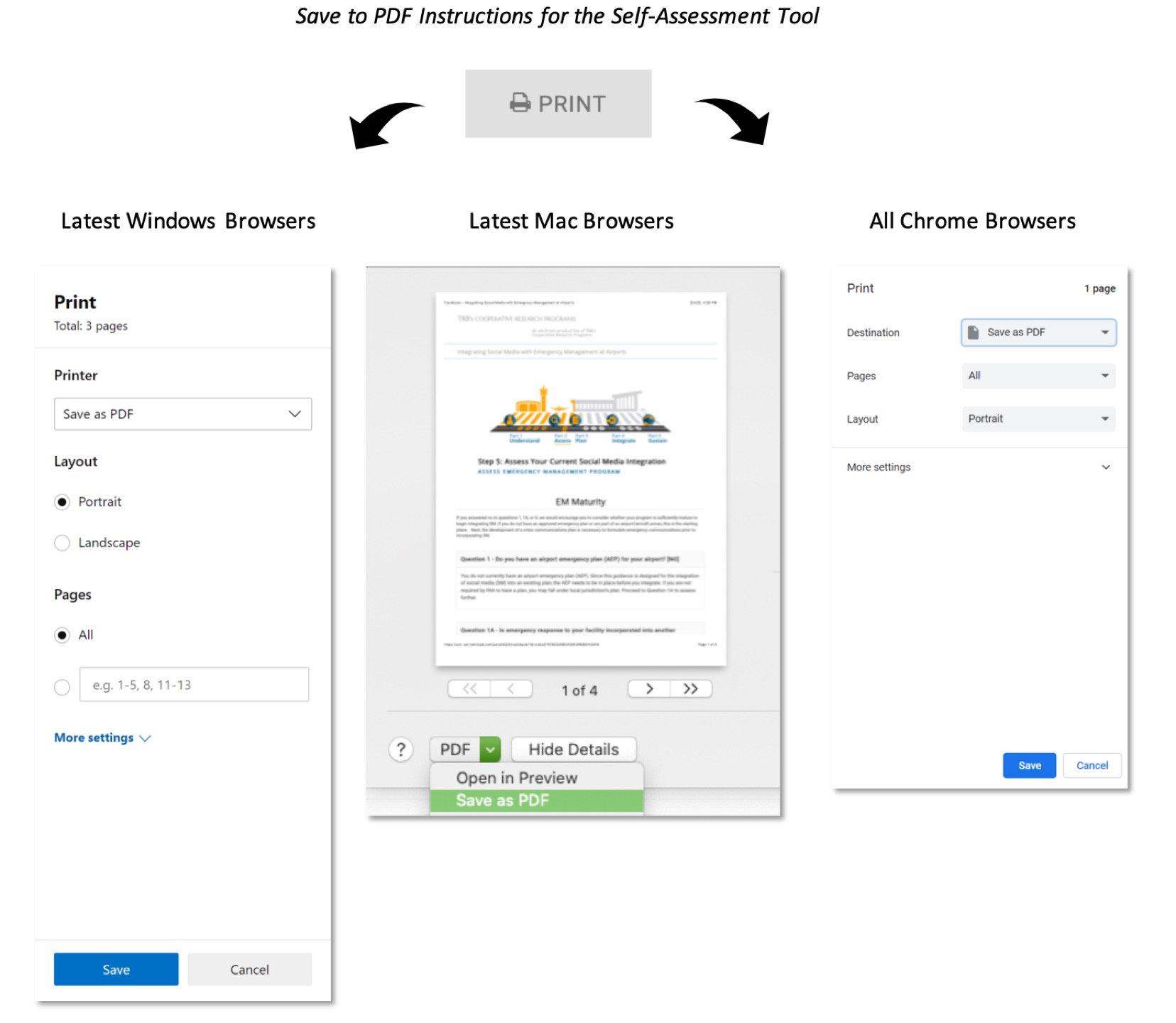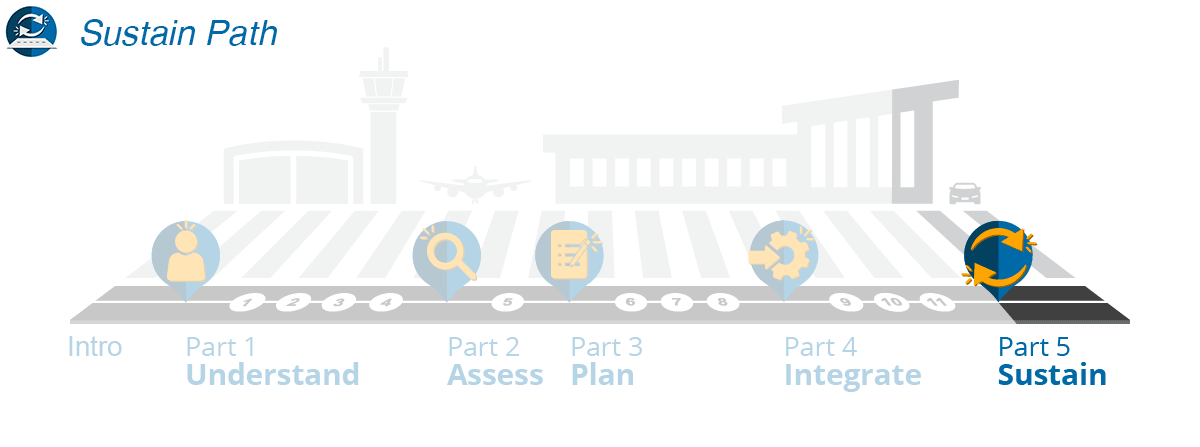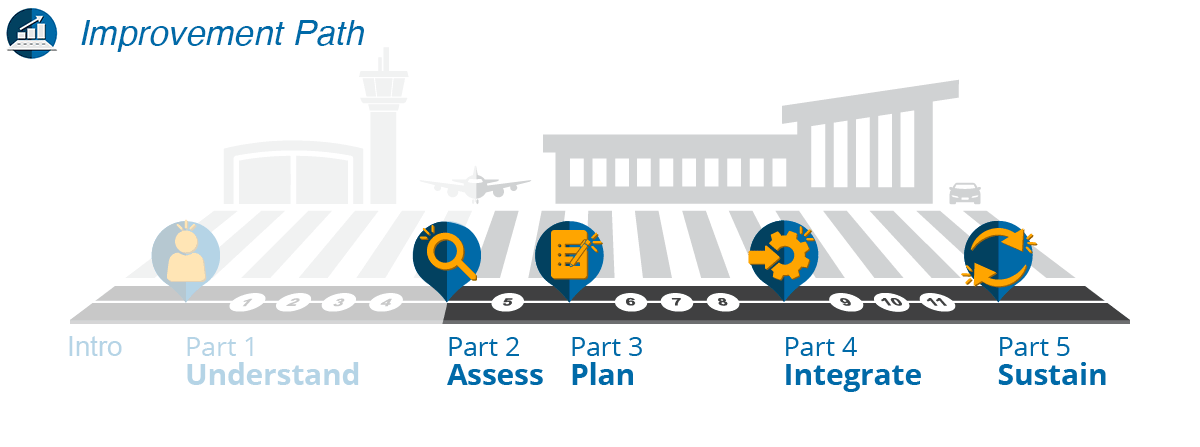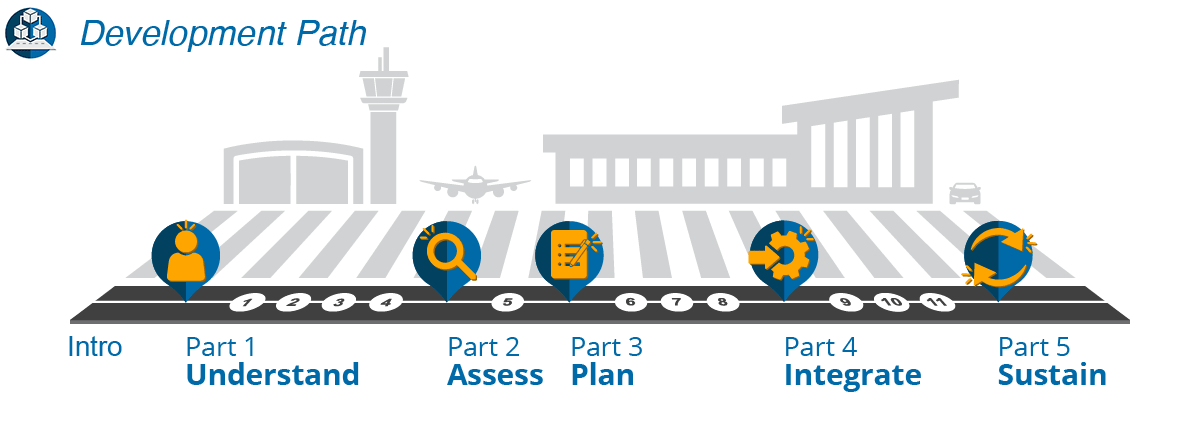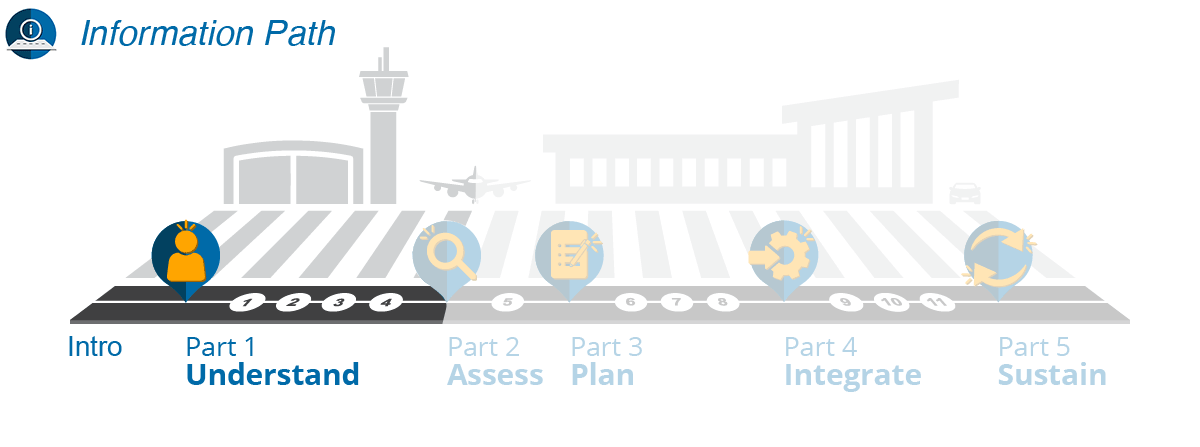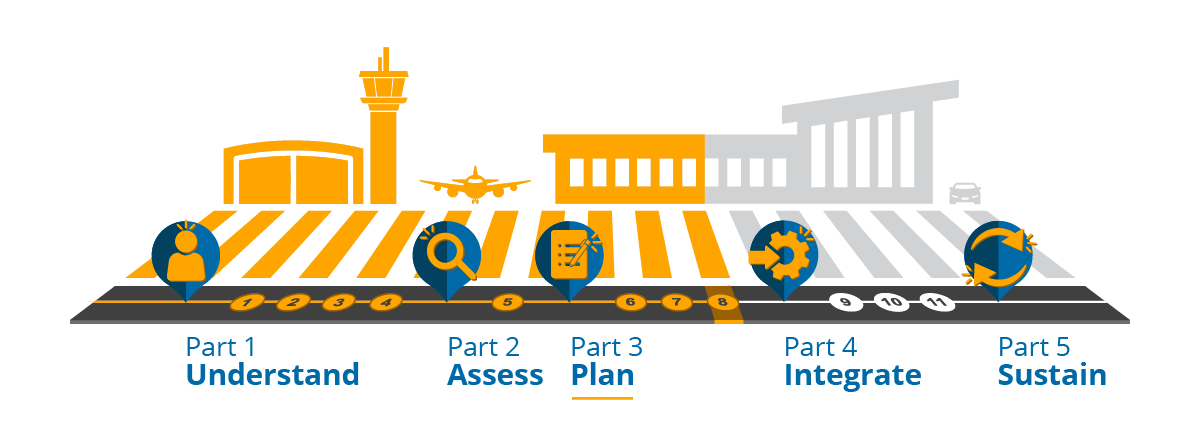
Step 8: Define Your Social Media Integration
Define the Integration Level
The level of SMEM that you plan to implement is tied to the vision, goals, and objectives you defined in Step 7. Each of the three (3) levels of integration (basic, intermediate, and complete) are built on the following points of integration. If you need to refresh yourself on these concepts, refer back to Step 7.
- Shared Understanding of SMEM and Associated Benefits
- Policies, Agreements, and Procedures
- SM Tools and Personnel Resources
- SM Training
- SM Drills/Exercises
As you jump into the levels of integration, you may decide a hybrid of two levels is a more ideal goal to start with than one level. That is perfectly understandable; these levels are meant to provide a framework from which you can build what works best for you.
 Basic Integration
Basic Integration
The basic level of integration represents the baseline that airport operators should achieve. It requires the smallest amount of resources and gives a taste of the benefits SMEM integration can provide. Basic integration includes the following points:
Shared Understanding of the Integration of SMEM and Associated Benefits
- Emergency management (EM) and SM professionals understand that SM is an important factor to consider in emergency preparedness and response. This understanding is promoted, at a minimum, within the airport community and within the whole community as time and resources permit.
- EM professionals understand the basics of SM and how SM professionals can monitor and use SM to inform emergency response.
- SM professionals understand how SM can be used to support an emergency response.
Policies, Agreements, and Procedures
- The airport operator has at least a simple airport emergency plan (AEP). For those under a jurisdictional authority, the jurisdiction’s emergency plan should have an airport incident annex.
- The airport operator has a basic crisis communications plan (CCP).
- Basic formal policies, agreements, and procedures exist to help the airport community/stakeholders understand their roles and responsibilities. Detailed procedures, checklists, and templates may not exist.
SM Tools and Personnel Resources
- Basic SM listening and reporting tools are available.
- Basic SM engagement tools may be provided depending upon funding and staffing.
- Personnel resources are limited, and responsibilities are shared among the resources available.
SM Training
- Initial training on SMEM is conducted, but recurrent training is limited.
- Use of online or free resources (such as those from whole community partners) can bolster what the airport operator may be able to provide.
SM Drills/Exercises
- SMEM policies and procedures are drilled on a very limited basis and agreements are reviewed.
- Orientation and tabletop exercises are utilized to minimize costs.
- Partnering with other entities and integrating SM into an existing exercise is used to minimize costs and staff resourcing.
The basic level of integration should be used by airport operators that are at a lower risk of having to handle a significant emergency event. This includes airports with fewer operations, fewer staff/stakeholders, and a location further removed from significant community infrastructure.
 Intermediate Level
Intermediate Level
The intermediate level represents a great next step to which airport operators should aspire. While it does require additional resources, it provides a greater level of benefits realized. Intermediate integration includes the following points:
Shared Understanding of SMEM and Associated Benefits
- EM and SM professionals demonstrate a thorough understanding of how SM can be used to inform emergency responders, stakeholders, and the public. This understanding is promoted with the whole community as time and resources permit.
- EM professionals understand how SM professionals listen and use SM to inform and support emergency response.
Policies, Agreements, and Procedures
- The airport operator has a dedicated AEP (to the extent possible, airport operators who are not Part 139 Certified have an understanding of the Federal Aviation Administration (FAA) requirements, but also go beyond just the template and truly customize the plan for their airport).
- The airport operator has a CCP.
- Detailed formal policies, agreements, and procedures exist regarding how SM will be used during emergency events. This includes clear, defined roles and responsibilities.
- Policy support documents, such as checklists, templates, etc. are available but may be limited.
SM Tools and Personnel Resources
- SM listening tools for following multiple channels are provided.
- Basic SM engagement and publishing tools are provided. The level of sophistication may be dependent upon funding and staffing.
- More advanced reporting and analytics are developed and implemented.
- Personnel resources are limited, with a mix of on-airport and shared responsibilities.
SM Training
- SMEM training is regularly conducted to ensure a consistent understanding of tools, policies, and procedures.
- Updates to training materials may be limited, but they are assessed annually to ensure they remain current with technology and SM trends.
- Basic Incident Command System (ICS) training is conducted, along with the Federal Emergency Management Agency's (FEMA’s) "Social Media in Emergency Management" (IS-42) training for command level and joint information center (JIC) staff.
SM Drills/Exercises
- SMEM policies and procedures are drilled, and agreements are reviewed at least annually.
- Procedures are updated based on lessons learned.
The intermediate level of SMEM integration should be pursued by airports that have a tangible risk of an emergency event but lack the resources and funding necessary to pursue a complete integration.
 Complete Integration
Complete Integration
The complete level represents the most desirable integration for all airport operators. That said, for many airports, it may not be the most ideal level due to the resources necessary to implement and sustain the program. Airport operators that implement this level will begin to realize the full spectrum of benefits offered by SM integration. Complete integration includes the following points:
Shared Understanding of SMEM and Associated Benefits
- SM is seen by all as a tool to aid in emergency response.
- EM and SM professionals demonstrate a common understanding of how SM can be used to inform an emergency response and the associated stakeholders and employees.
- SM may be used for internal collaboration during emergency events as well as regularly during day-to-day, non-emergency operations and engagement.
Policies, Agreements, and Procedures
- The airport operator has a dedicated AEP in compliance with FAA Part 139 Advisory Circulars and emergency management best practices.
- The CCP is integrated with AEPs.
- Detailed formal plans, policies, agreements, and procedures exist regarding how SM will be used during emergency events, and they are supported with templates, checklists, and other similar items.
- Metrics for establishing proper baselines are established and tracked during incidents to guide SM use and complete post-incident assessments.
SM Tools and Personnel Resources
- Sophisticated tools enabling listening, engagement, publishing, and reporting are utilized.
- Real-time analytics are utilized.
- Dedicated SM and EM staff are provided.
SM Training
- Regular SMEM training is conducted. Efforts are made to ensure personnel stay current on new and emerging trends in SM technology.
- SM tool users may obtain certification on various tools/products.
- Advanced ICS classes along with FEMA’s "Social Media in Emergency Management" (IS-42) training for command level, emergency operations center (EOC), and JIC staff are conducted.
SM Drills/Exercises
- SMEM functions are drilled regularly and updates are made to policies and procedures based on lessons learned. Agreements are reviewed annually.
- SM components are exercised during JIC functional or full-scale exercises.
The complete level of SMEM should be pursued by larger airports with a significant number of operations and with a higher potential risk for emergency events. That does not mean smaller airports cannot aspire to this level. It simply means that smaller airports should weigh the level of investment in the program against the benefits they would realize.
Airport operators and the associated community should strive to be candid and realistic in defining the level of integration. As you familiarize yourself with the content in this section, take a tiered approach. Follow the “Do 1 Thing” model to continually make progress toward your needed/desired level of integration; but do so at a speed and commitment level that you can support.
The next section, “Determine the SM Functions to Integrate” goes further into using SM management functions in preparation for Step 9: Establish Your Integration Needs and Step 10: Establish the Social Media Operating Framework.
REFERENCES
1. “Do 1 Thing,” Do 1 Thing, accessed September 13, 2019, https://do1thing.com/.
